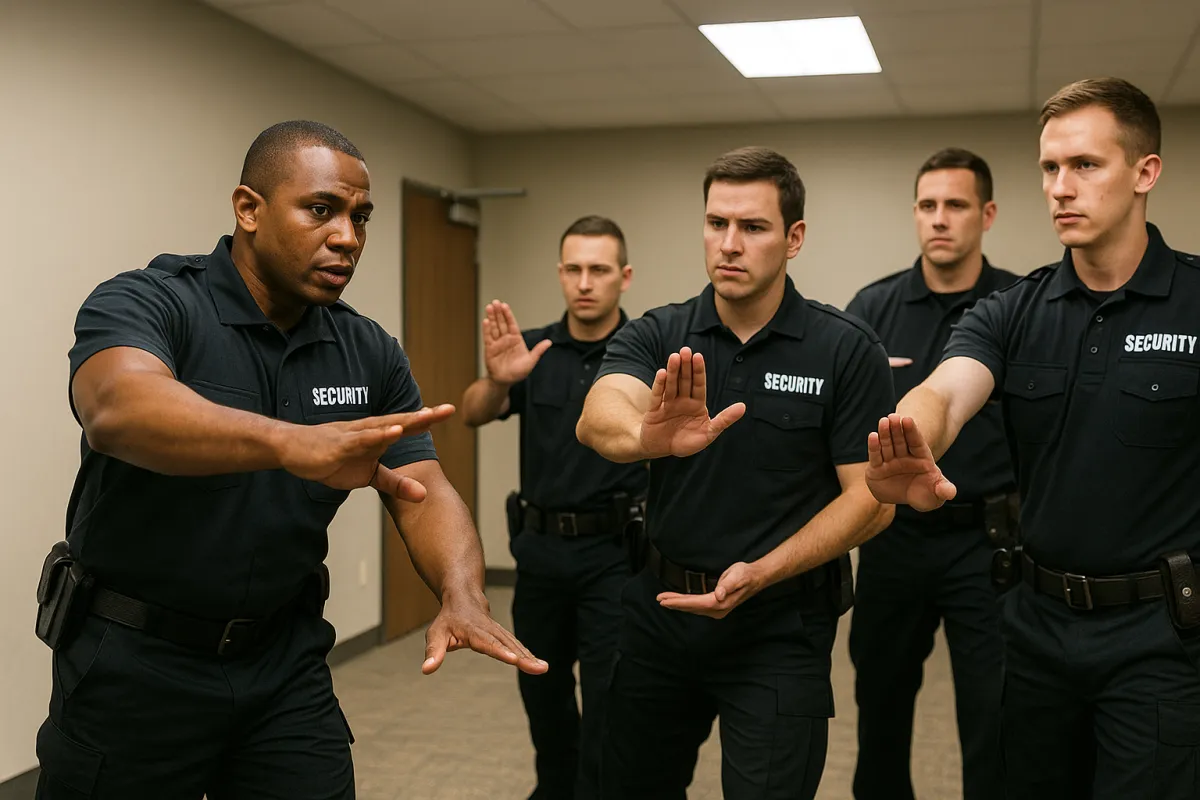Blog & News

Why Ongoing Guard Training Is Non-Negotiable
Why Ongoing Guard Training Is Non-Negotiable
Security threats evolve constantly. New technologies emerge, regulations change, and adversaries adapt their tactics. To stay ahead, security officers cannot rely solely on their initial certification; they must engage in ongoing training that reinforces core skills, introduces novel tactics, and ensures compliance with ever-shifting legal requirements. At Steel Bison Security, we view continuous education as the bedrock of a professional guard force.
1. The Evolving Threat Landscape
1.1. From Static Risks to Sophisticated Adversaries
Yesterday’s security concerns—vandalism, petty theft, unauthorized access—have given way to complex scenarios:
Cyber-Physical Attacks targeting IoT devices and PSIM platforms
Active Threat Incidents requiring coordinated multi-agency responses
Insider Threats exploiting social engineering and credential misuse
According to the Department of Homeland Security, nearly 90% of critical infrastructure sites reported at least one significant intrusion attempt in the past five years. To counter these, officers must periodically update their knowledge base and adapt their skill sets. See the DHS overview: DHS Risk Management.
1.2. Legal and Regulatory Shifts
Laws governing use-of-force, data privacy, and workplace safety undergo frequent revisions. For example, OSHA’s guidelines on workplace violence prevention were updated in 2021 to emphasize verbal de-escalation and reporting protocols. Guards trained only on pre-2021 standards risk violating policy. Review OSHA’s standards: OSHA Workplace Violence.
2. Skills Atrophy and the Need for Reinforcement
2.1. The Forgetting Curve
Human memory decays over time: without repetition, complex procedures slip away at a rate of up to 70% within a month. Key security skills—patrol routines, emergency radio codes, first-aid procedures—demand regular refreshers to ensure instant recall during crises.
2.2. Scenario Complexity Requires Practice
Static classroom lectures cannot replicate the stress of real incidents. Scenario-based drills—active shooter simulations, fire evacuations, medical emergencies—embed muscle memory and decision-making frameworks. Research in law enforcement training shows that officers who train under simulated stress perform 50% better in live scenarios than those without such practice.
3. Regulatory, Legal & Liability Considerations
3.1. Compliance and Accreditation
Agencies like ASIS International publish standards (e.g., PSC.1-2012 Quality Standards for Security Management) requiring documented ongoing training. Failure to comply can lead to loss of accreditation and client trust.
3.2. Reducing Negligent Security Claims
Courts increasingly view lack of continuous training as negligence. In a landmark 2019 case, a night-club was found liable for assault damages because guards had not completed mandated de-escalation workshops in over two years. Robust training records are your best defense against civil suits.
3.3. Insurance Considerations
Insurers often demand evidence of annual or semi-annual training in CPR, use-of-force, and site-specific protocols. Meeting these requirements can yield lower premiums and broader coverage.
4. Integrating New Technologies and Tactics
4.1. Cyber-Physical Security Tools
Training must cover:
PSIM Platforms that unify CCTV, access control, and alarms
Mobile Patrol Apps for GPS-verified checkpoints and real-time reporting
Network-ed Camera Analytics identifying loitering, tailgating, or unauthorized entry
4.2. Non-Lethal Options and Use-of-Force Updates
The rise of non-lethal tools—PEP spray, tasers, guided baton techniques—requires regular certification and legal updates. Newer jurisdictions now limit or ban certain devices, so guards must stay current to avoid violations.
5. Best Practices for an Ongoing Training Program
5.1. Multi-Modal Learning
Combine online modules, classroom sessions, and hands-on drills. For example:
E-Learning for policy updates and scenario walkthroughs (20% of program)
Instructor-Led Workshops for interpersonal skills, legal refreshers (30%)
Practical Drills & Simulations under stress (50%)
5.2. Regular Frequency and Structured Curriculum
Monthly Micro-Modules: 15-minute online refreshers on core topics (e.g., radio codes, evacuation routes).
Quarterly Full-Day Workshops: In-depth sessions on use-of-force, ethics, and new tools.
Annual Certification: Comprehensive assessment—written and practical—to renew credentials.
5.3. Tailoring to Site-Specific Needs
Each property has unique risks. Develop post orders that incorporate local SOPs, then run drills in the actual environment—parking lots, loading docks, server rooms—to reinforce familiarity.
5.4. Engaging Expert Instructors
Leverage specialists for niche topics:
Medical Response: Certified EMTs for first-aid and CPR recertification
Active Threat: Law-enforcement or tactical instructors for shooter drills
Cyber Awareness: IT security professionals for phishing and social engineering training
6. Measuring Training Effectiveness
6.1. Key Performance Indicators (KPIs)
Track metrics such as:
Retention Rates: Percentage of correct responses on post-training quizzes
Response Times: Average time from alarm to on-site arrival
Drill Success Rates: Percentage of objectives met in full-scale exercises
6.2. Audit and Feedback Loops
Supervisor Ride-Alongs: Unannounced checks to observe SOP adherence
Officer Self-Assessments: Encourage guards to reflect on drills and identify gaps
Client Surveys: Gather stakeholder feedback on perceived professionalism and response quality
7. Real-World Case Study: From Lapse to Excellence
Background: A suburban medical campus suffered three minor security incidents—trespassing, misplaced PHI files, and delayed medical emergency response—in six months.
Intervention:
Gap Analysis: Identified training voids in HIPAA privacy protocols and nocturnal patrol procedures.
Custom Curriculum: Rolled out a three-month program: monthly HIPAA refreshers, biweekly night patrol drills, and quarterly active-shooter tabletop exercises.
Technology Integration: Introduced mobile patrol apps and CCTV analytics training.
Results: In the following year:
Incidents dropped by 85%.
Response times improved by 40%.
Client satisfaction scores rose by 30%.
This transformation illustrates the power of structured, ongoing training.
8. How Steel Bison Security Delivers Continuous Training
At Steel Bison Security, we embed ongoing education into our operational DNA:
Dedicated Training Department: Coordinates curricula, instructor certifications, and regulatory updates.
Learning Management System (LMS): Tracks completion of e-modules, schedules in-person workshops, and automates reminders.
On-Site Tailored Drills: We run monthly drills at client locations, using real layouts and equipment.
Performance Dashboards: Clients access KPIs—training hours, drill outcomes, certification statuses—through our secure portal.
Continuous Improvement Forums: Quarterly meetings with clients to review training effectiveness and plan enhancements.
Visit our services page or contact us to learn how we can build a training program that never rests.
9. Conclusion
Ongoing guard training is non-negotiable in today’s dynamic security environment. By reinforcing core skills, updating legal and technical knowledge, and practicing under realistic conditions, security officers maintain peak readiness—protecting assets, people, and reputations. A structured, multi-modal training regimen not only reduces risk and liability but also demonstrates professionalism to clients and insurers alike. Partner with Steel Bison Security to implement a continuous training program that keeps your security posture strong—around the clock.
Invest in your guards. Invest in ongoing training. Contact Steel Bison Security today to secure your future.

EMAIL ADDRESS
OFFICE NUMBER
OFFICE ADRESS
(WA) 11900 NE First St STE 3066, Bellevue, Wa 98005
(WY) 30 N. Gould St STE R, Sheridan, Wy 82801
Copyright 2024 Steel Bison Security Services
